Cloud Computing Market by Service Model (IaaS, PaaS, SaaS), Deployment Model(Public Cloud, Private Cloud, Hybrid Cloud), Organization Size, Vertical (BFSI, Telecommunications, Manufacturing, Retail & Consumer Goods) and Region - Global Forecast to 2028
[345 Pages Report] The global cloud computing market is expected to grow from USD 626.4 billion in 2023 to USD 1,266.4 billion by 2028 at a CAGR of 15.1% during the forecast period.
The growth of the cloud computing market is the growing demand of the retail & consumer goods and healthcare & life sciences industries. It has witnessed the fastest growth owing to the increasing adoption of AI, ML, Big Data, edge computing, and 5G technologies. The key reasons for adopting these technologies are that cloud computing can support SaaS, PaaS, and IaaS service models.
Cloud computing has become an indispensable part of modern business operations, offering a wide range of benefits driving its rapid adoption. The versatility of cloud computing has led to its adoption across various industries and diverse use cases. Cloud storage services like Amazon S3, Microsoft Azure Blob Storage, and Google Cloud Storage provide scalable and secure storage for data of all types, including documents, images, videos, and files; this eliminates the need for businesses to invest in and maintain on-premises storage infrastructure. PaaS provides developers with a cloud-based platform for building, deploying, and managing applications; this eliminates the need for businesses to invest in and maintain development infrastructure. These are driving factors of the cloud computing market.
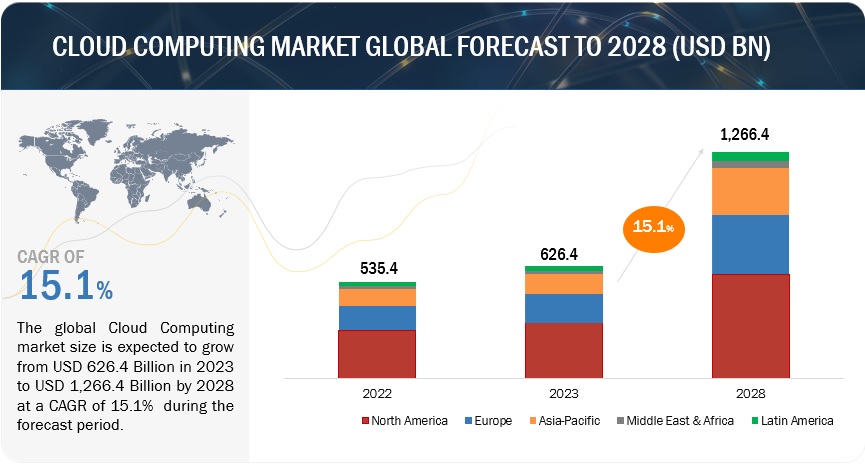
To know about the assumptions considered for the study, Request for Free Sample Report
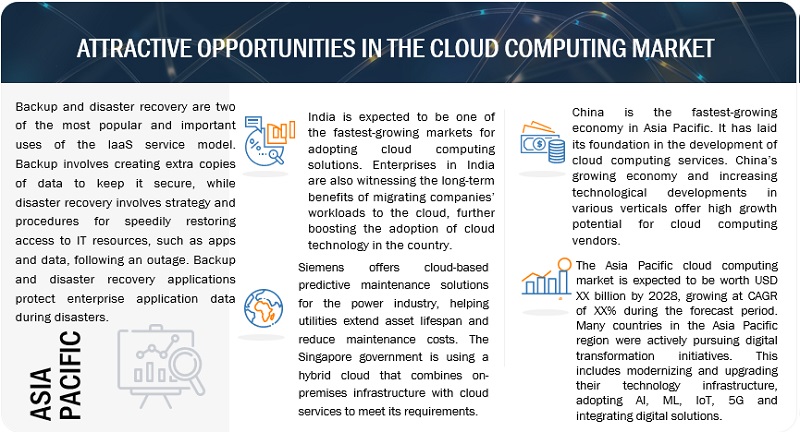
To know about the assumptions considered for the study, download the pdf brochure
Drivers: Accelerated spending on cloud
Businesses aim to expand quickly and capture a significant market share. Achieving this goal entails streamlining operations by ensuring data is readily available at every touchpoint. Cloud computing services facilitate business functionalities by providing access to information across all devices anytime and from anywhere. As businesses evolve to meet customers’ needs, the demand for cloud computing services is growing, and their reliability is improving. During the first quarter of 2020, cloud spending rose 37% to USD 29 billion. The increasing need for scalable, secure, dependable, and affordable resources off-premises is driving the demand for cloud computing services. Despite the expected economic slowdown due to the pandemic, cloud spending increased by 19% in 2020, even though IT spending will decline by 8%. According to recent data, corporate spending on cloud computing is growing at double-digit rates as chief information officers and other tech leaders choose cutting-edge features such as artificial intelligence that are more expensive than standard business apps. Due to the current macroeconomic conditions, cloud leaders are increasingly using cloud-based services (42%), planning to migrate from legacy software to cloud-based tools (33%), and migrating on-premises workloads to the cloud (32%).
Restraint: Lack of technical knowledge and expertise
Organizations require staff with technical skills and knowledge to implement, process, analyze, and secure cloud solutions. However, there is a severe scarcity of technical skills among IT workers, particularly in cloud computing. This lack of expertise is causing companies to miss out on the benefits of the cloud and emerging technologies, ultimately leading to a loss of market share and revenue. Companies struggle to find suitable candidates due to challenges, including rapid hiring processes, high wages for experienced cloud workers, and difficulty finding individuals who align with the organization’s culture. If the shortage of cloud workers continues, the company’s growth engines could sputter. Despite 80% of IT leaders recognizing that the lack of skilled workers prevents companies from expanding their modern software engineering and cloud environments, over 90% plan to achieve this goal.
Opportunities: Adoption of IoT and connected devices
The technological landscape evolves with innovations added every day. Two of the closely related future internet technologies are IoT and cloud computing. IoT provides a foundation for cloud computing to succeed. IoT devices produce data that must be collected and processed locally or remotely on a server. In many IoT applications, remote data hosting and analytics are more practical and cost-effective solutions. As IoT and cloud computing continue to expand, there is also a growing interest in edge computing. Edge computing can help reduce the demand for cloud storage by pre-filtering data and sending only some of it to distant servers.
Moreover, edge computing has enormous promise for real-time data analytics. In the future, it is likely to work in conjunction with IoT devices and cloud computing, providing an even better framework for the constantly growing data streams from massive IoT applications. However, moving all data processing and storage back to the edge is impractical for most businesses.
Challenges: High complexity due to the adoption of multi-cloud model
Lean IT teams are facing new challenges in addressing their current difficulties. Businesses have traditionally focused on cost control, efficiency improvement, and process optimization. However, the pandemic has forced them to prioritize deployments, leading to a rush towards public cloud solutions without adequate due diligence; this has resulted in increased complexity, higher costs, and less flexibility, with little focus on achieving strategic business goals. According to a recent study, 87% of respondents agree that managing mixed-cloud infrastructures is essential for multi-cloud success. As multi-cloud deployments become more common, organizations face various challenges in managing cloud resources. Cloud computing operates at multiple levels, each with its best practices and deployment rules, making it difficult to use in multi-cloud scenarios. The complexity of managing cloud resources increases with each additional cloud environment used. The management burden also increases with the number of public cloud vendors used, as no industry standards exist. Therefore, it is crucial to review the security measures of each vendor and understand the breadth of their security measures before signing up for multi-cloud services.
Ecosystem
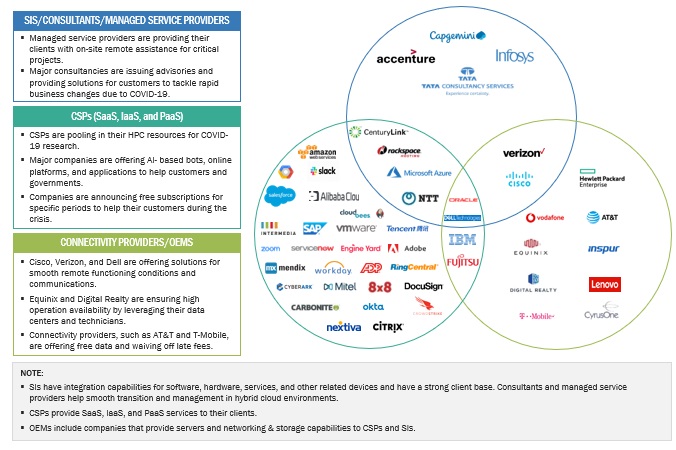
Based on the deployment model, the hybrid cloud segment significantly contributes the highest CAGR to the cloud computing market during the forecast period.
Hybrid cloud in cloud computing refers to an IT architecture incorporating some degree of workload portability, orchestration, and management across two or more environments, including on-premises data centers, private clouds, and public clouds. The hybrid cloud model allows organizations to take advantage of the benefits of both private and public clouds, providing greater flexibility, scalability, and optimization of resources. A hybrid cloud will enable organizations to move applications and workloads between private and public clouds based on specific needs. This flexibility is valuable for managing varying demands and optimizing costs. A hybrid cloud provides the capability to have redundant and backup systems across different environments. In case of a failure or disaster in one location, workloads can be shifted to another environment, ensuring business continuity. A hybrid cloud allows organizations to optimize costs by choosing the most cost-effective platform for each workload. It also enables a pay-as-you-go model for resources consumed from public clouds.
Based on the vertical, the BFSI segment holds a significant cloud computing market share during the forecast period.
Payment gateways, online fund transfers, digital wallets, and unified customers play a significant role in the BFSI industry, facilitating the transition to cloud deployment. BFSI companies have started using Infinity Distribution Services, a suite of cloud-based banking distribution services launched by Switzerland-based company Temenos. The company leverages AI to modernize its legacy systems into digital platforms. These platforms would enable banks to offer digital onboarding services, fund authorization, marketing, and other services that banks of any size can deploy in any pandemic. Additionally, MACIF Group, a French mutual insurance provider, has deployed Microsoft’s G Suite for over 8,000 employees to ensure business continuity. This deployment has allowed employees to shift from in-person to more than 1,300 Google Meet video meetings daily. Regulatory Compliance and Reporting- Cloud-based compliance solutions help banks manage and maintain compliance with complex and ever-changing regulatory requirements. These solutions automate compliance tasks, provide real-time reporting, and ensure adherence to data privacy regulations. Mobile Payments and Transfers- Cloud-based solutions facilitate secure and convenient mobile payments, money transfers, and bill payments, enabling customers to manage their finances seamlessly from their smartphones or tablets.
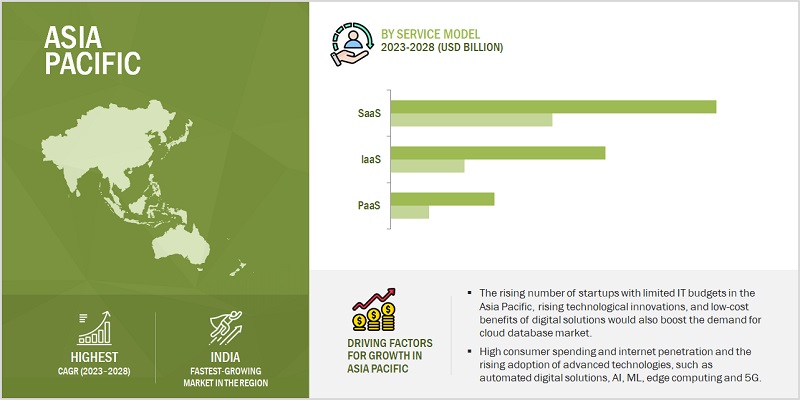
Asia Pacific to grow at the highest CAGR during the forecast period.
The adoption of advanced technologies, such as IoT and AI, edge computing, and 5G across verticals will drive the growth of the cloud computing market in the Asia Pacific. The increasing investments from private sectors, robust government support, and availability of a vast population drive the growth of new and emerging technologies in the Asia Pacific. Many countries in the Asia-Pacific region are embracing AI and machine learning technologies across industries, including finance, healthcare, retail, and manufacturing. Japan is one of the most advanced countries in terms of ICT development. It has always been a frontrunner in adopting advanced technologies like IoT, LTE, SDN, and AI. With the expansion in public cloud technologies, many enterprises in Japan want to switch their core applications to the cloud. With migration toward the cloud over the next five years, IaaS and PaaS are likely to surpass the growth of the SaaS model, which would increase the adoption rate of cloud computing in the region. According to secondary data, the country has been ranked second on the Global Cloud Computing Scoreboard. Therefore, Japanese companies are the main reason for promoting R&D investments for technological advancements. The expansion of the cloud computing market in Australia is due to the prevalence of numerous channel partners in the region, including VAR distributors, and their ongoing efforts to assist customers in switching to the cloud. The country presents attractive opportunities for cloud-based technologies due to the availability of advanced and reliable cloud infrastructure. Most MSPs in Australia are helping enterprises navigate various cloud options and migrate the existing workloads to multiple cloud environments, leading to the growing adoption of the multi-cloud strategy in Australia.
Key Players
AWS (US), Microsoft (US), IBM (US), Google (US), Alibaba Cloud (China), SAP (Germany), Salesforce (US), Oracle (US), Adobe (US), Workday (US), Fujitsu (Japan), VMware (US), Rackspace (US), DXC (US), Tencent Cloud (China), NEC (Japan), DigitalOcean (US), Joyent (US), Skytap (US), OVH (France), Navisite (US), CenturyLink (US), Infor (US), Sage (UK), Intuit (US), OpenText (Canada), Cisco (US), Box (US), Zoho (US), Citrix (US), Epicor (US), Upland Software (US), ServiceNow (US), IFS (Sweden), App Maisters (US), Zymr (US), JDV Technologies (India), Tudip Technologies (India), Visartech (US), Cloudflex (Nigeria), Cloudways (Malta), Vultr (US), and pCloud (Switzerland) are the key players in the cloud computing market.
Get online access to the report on the World's First Market Intelligence Cloud
- Easy to Download Historical Data & Forecast Numbers
- Company Analysis Dashboard for high growth potential opportunities
- Research Analyst Access for customization & queries
- Competitor Analysis with Interactive dashboard
- Latest News, Updates & Trend analysis
Request Sample Scope of the Report
Get online access to the report on the World's First Market Intelligence Cloud
- Easy to Download Historical Data & Forecast Numbers
- Company Analysis Dashboard for high growth potential opportunities
- Research Analyst Access for customization & queries
- Competitor Analysis with Interactive dashboard
- Latest News, Updates & Trend analysis
|
Report Metric |
Details |
|
Market size available for years |
2018–2028 |
|
Base year considered |
2022 |
|
Forecast period |
2023–2028 |
|
Forecast units |
Billion (USD) |
|
Segments Covered |
Service Model, Deployment Model, Organization Size, Vertical, and Region |
|
Geographies covered |
North America, Europe, Asia Pacific, Middle East & Africa, and Latin America |
|
Companies covered |
AWS (US), Microsoft (US), IBM (US), Google (US), Alibaba Cloud (China), SAP (Germany), Salesforce (US), Oracle (US), Adobe (US), Workday (US), Fujitsu (Japan), VMware (US), Rackspace (US), DXC (US), Tencent Cloud (China), NEC (Japan), DigitalOcean (US), Joyent (US), Skytap (US), OVH (France), Navisite (US), CenturyLink (US), Infor (US), Sage (UK), Intuit (US), OpenText (Canada), Cisco (US), Box (US), Zoho (US), Citrix (US), Epicor (US), Upland Software (US), ServiceNow (US), IFS (Sweden), App Maisters (US), Zymr (US), JDV Technologies (India), Tudip Technologies (India), Visartech (US), Cloudflex (Nigeria), Cloudways (Malta), Vultr (US), and pCloud (Switzerland). |
This research report categorizes the Cloud Computing market based on Service Model, Deployment Model, Organization Size, Vertical, and Region.
Based on the service model, the Cloud Computing market segments are as follows:
-
Infrastructure as a Service (IaaS)
- Primary storage
- Disaster Recovery & Backup
- Archiving
- Compute
-
Platform as a Service (PaaS)
- Application Development & platforms
- Application Testing & Quality
- Analytics & Reporting
- Data Management
-
Software as a Service (SaaS)
- Customer Relationship Management
- Enterprise Resource Management
- Human Capital Management
- Content Management
- Collaboration & Productivity Suites
- Supply Chain Management
- Other SaaS service models
Based on the deployment model, the Cloud Computing market segments are as follows:
- Public Cloud
- Private Cloud
- Hybrid Cloud
Based on organization size, the Cloud Computing market segments are as follows:
- Large Enterprises
- Small & Medium Enterprises
Based on vertical, the Cloud Computing market segments are as follows:
- BFSI
- Energy & Utilities
- Government & Public Sector
- Telecommunications
- IT & ITeS
- Retail & Consumer Goods
- Manufacturing
- Media & Entertainment
- Healthcare & Life Sciences
- Other Verticals
Based on regions, the Cloud Computing market segments are as follows:
-
North America
- US
- Canada
-
Europe
- UK
- Germany
- France
- Italy
- Netherlands
- Rest of Europe
-
Asia Pacific
- China
- Japan
- Australia
- Singapore
- India
- South Korea
- Rest of Asia Pacific
-
Middle East & Africa
-
Gulf Cooperation Council (GCC)
- UAE
- Saudi Arabia
- Qatar
- The rest of the GCC Countries (Bahrain, Oman, and Kuwait)
- South Africa
- Rest of the Middle East & Africa
-
Gulf Cooperation Council (GCC)
Recent Developments
- In January 2023, the Apsara Developer Community, a new center developed to help worldwide developers through an increased offering of different developer tools and services, was unveiled by Alibaba Cloud. It aspires to foster the continued expansion of the developer community while facilitating the advancement of the digital economy across markets.
- In October 2023, BT and Google Cloud launched a new relationship centered on a more substantial commitment to cybersecurity innovation. BT would become a managed services delivery partner for Google’s Autonomic Security Operations (ASO) product based on Google Chronicle as part of the partnership.
- In June 2023, IBM acquired Agyla SAS. To extend IBM Consulting’s localized cloud expertise for French clients, IBM bought Agyla SAS, a leading cloud professional services provider in France. The acquisition will broaden IBM’s hybrid multi-cloud services portfolio and enhance the company’s hybrid cloud and AI ambitions in the region.
Frequently Asked Questions (FAQ):
How big is the cloud computing market?
The global cloud computing market size is expected to grow from USD 626.4 Billion in 2023 to USD 1,266.4 Billion by 2028 at a CAGR of 15.1%during the forecast period.
Which region has the highest market share in the cloud computing market?
North America has the highest market share in the cloud computing market.
What is the market definition of the cloud computing market?
Cloud computing is the on-demand delivery of IT resources over the Internet with pay-as-you-go pricing. Instead of buying, owning, and maintaining physical data centers and servers, users can access technology services, such as computing power, storage, and databases, on an as-needed basis from a cloud provider.
Who are the major vendors in the cloud computing market?
AWS (US), Microsoft (US), IBM (US), Google (US), Alibaba Cloud (China), SAP (Germany), Salesforce (US), Oracle (US), Adobe (US), Workday (US), Fujitsu (Japan), VMware (US), Rackspace (US), DXC (US), Tencent Cloud (China), NEC (Japan), DigitalOcean (US), are some of the key vendors in the market.
What are the drivers in the cloud computing market?
Many organizations are adopting AI to train machines, optimize resource utilization, and achieve better results. However, they often lack the expertise to implement this technology in their business functions. Cloud technology is accelerating the deployment of AI on a large scale, resulting in increased spending on AI. Cloud computing services provide automated tools that offer enhanced scalability and agility, enabling organizations to achieve appropriate automation levels. These services automate repetitive tasks and allow employees to perform other essential business tasks. Analysts and tech companies predict future AI applications with various use cases in many industries. Cloud computing and delivery strategies will play a crucial role in shaping the utilization of AI use cases. So, the demand for AI is driving the growth of the market.
What are some challenges in the cloud computing market?
One of the most challenging difficulties is the risk of vendor lock-in. The lack of industry standards has made vendor lock-in a significant obstacle to adopting cloud computing. Technological solutions and initiatives are trying to address this issue. However, the complexity of the problem is not realized due to limited research. As a result, many clients are unaware of proprietary standards that prevent them from quickly moving their applications and data from one vendor to another. .
To speak to our analyst for a discussion on the above findings, click Speak to Analyst
The study involved four major activities in estimating the market size for cloud computing. Exhaustive secondary research helped to collect information on the market, peer, and parent markets. The next step was to validate these assumptions, findings, and sizing with the industry experts across the value chain through primary research. Both bottom-up and top-down approaches were employed to estimate the complete market size. After that, we used market breakup and data triangulation to assess the overall market size of segments and sub-segments.
Secondary Research
We determined the market size of companies offering cloud computing solutions and services based on secondary data available through paid and unpaid sources. It was also arrived at by analyzing the product portfolios of major companies and rating the companies based on their performance and quality.
In the secondary research process, we referred to various secondary sources for identifying and collecting information for this study. The secondary sources include press releases, annual reports, & investor presentations, white papers, certified publications, articles from recognized associations, and government publishing sources.
We used secondary research mainly to obtain the critical information related to the industry’s value chain and supply chain to identify the key players based on solutions, services, market classification, and segmentation according to offerings of the major players, industry trends related to service model, verticals, and regions, and the key developments from both market- and technology-oriented perspectives.
Primary Research
In the primary research process, various sources from the supply and demand sides were interviewed to obtain qualitative and quantitative information on the market. The primary sources from the supply side included various industry experts, including Chief Experience Officers (CXOs); Vice Presidents (VPs); directors from business development, marketing, and product development/innovation teams; related executives from cloud computing vendors, industry associations, and independent consultants; and key opinion leaders.
We conducted primary interviews to gather insights, such as market statistics, the latest trends disrupting the market, new use cases implemented, data on revenue collected from products and services, market breakups, market size estimations, market forecasts, and data triangulation. Primary research also helped understand various technology trends, service models, end users, and regions. Demand-side stakeholders, such as Chief Information Officers (CIOs), Chief Technology Officers (CTOs), Chief Security Officers (CSOs), and digital initiatives project teams, were interviewed to understand the buyer’s perspective on suppliers, products, service providers, and their current use, which would affect the overall cloud computing market.
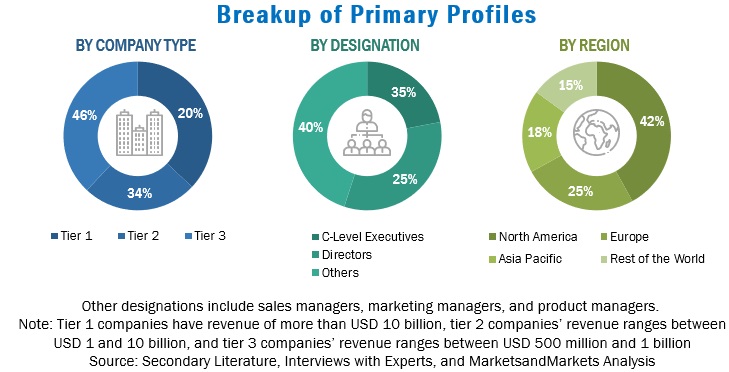
To know about the assumptions considered for the study, download the pdf brochure
Market Size Estimation
We used the top-down and bottom-up approaches to calculate the cloud computing market and subsegments. We finalized the vendors in the market via secondary research and their segment shares in regions/ countries through extensive market research. This procedure included studying major market players’ annual reports and extensive interviews with industry leaders.
- We identified key players in the market through secondary market analysis and their revenue contributions in respective regions through primary and secondary research.
- This procedure included studying top market players’ financial reports and interviews for key insights from experts.
- All percentage breakups were determined using secondary sources and verified through primary inputs.
Primary research has accounted for and verified all possible market parameters affecting the market. MarketsandMarkets consolidated the data with detailed inputs and analysis.
Bottom-Up Approach
In the bottom-up approach, we identified the adoption trend of cloud computing in key countries concerning regions contributing to most of the market share. The adoption trend of cloud computing and different use cases concerning their business segments was identified and extrapolated for cross-validation. Weightage was given to the use cases identified in other areas for the calculation. We prepared an exhaustive list of all vendors offering solutions and services in the cloud computing market. The revenue contribution of all vendors in the market was estimated through annual reports, press releases, funding, investor presentations, paid databases, and primary interviews. We considered vendors with cloud computing offerings to evaluate the market size.
We determined the geographic split with primary and secondary sources based on these numbers. The procedure included an analysis of the cloud computing market’s region-wise penetration. Various factors considered are – ICT spending and strategic vendor analysis of system integration service providers. Other factors analyzed were the socioeconomic analysis of each country and local and global players’ organic and inorganic business strategies.
With the data triangulation process and data validation via primaries, this study determined and confirmed the exact values of the overall cloud computing market and its segments’ market size.
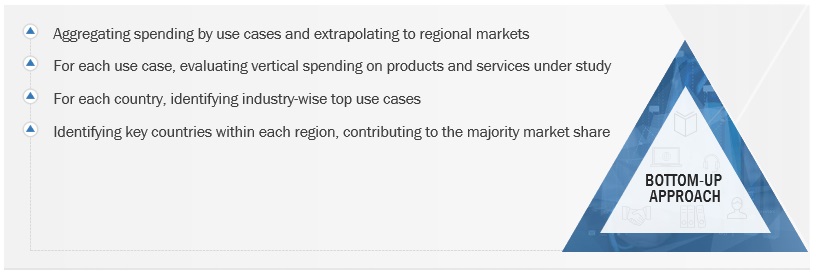
To know about the assumptions considered for the study, Request for Free Sample Report
Top-Down Approach
The top-down approach prepared a detailed list of vendors offering solutions and services in the cloud computing market. The revenue contribution for all vendors in the market was estimated through annual reports, PRs, investor presentations, funding, paid databases, and expert interviews. We evaluated players based on their offerings. The summation of all companies’ revenues was extrapolated to reach the overall market size. Each subsegment was further studied and analyzed for its global market size and regional penetration. The primary procedure included obtaining critical insights from industry leaders, such as VPs, CEOs, directors, and marketing executives. We derived the cloud computing market from cloud computing subscriptions adopted by different verticals. We triangulated the market numbers with the existing MarketsandMarkets KS repository for validation.

Data Triangulation
A research technique called data triangulation uses two or more methods to confirm findings and outcomes. It is employed to verify the findings’ integrity and ensure that the data support the hypothesis. Data triangulation, used frequently in qualitative research, entails confirming data by those who collected and analyzed it. With the data triangulation process and data validation through primaries, we established the exact values of the overall cloud computing market and its segments’ market size.
Market Definition
Cloud computing is an on-demand delivery of a virtual environment, which includes a pool of resources, such as computing, storage, application, database, and network, through pay-as-you-go pricing service models, which enable enterprises to host their workloads.
Key Stakeholders
- Cloud Service Providers (CSPs)
- Networking companies
- Information Technology (IT) infrastructure providers
- Consultants/Consultancies/Advisory firms
- Component providers
- Telecom service providers
- System Integrators (SI)
- Support and maintenance service providers
- Support service providers
- Third-party providers
- Government organizations and standardization bodies
- Datacenter providers
- Regional associations
- Independent hardware and software vendors
- Value-added resellers and distributors
Report Objectives
- To define, describe, and forecast the global cloud computing market based on the service model, Infrastructure as a Service (IaaS), Platform as a Service (PaaS), Software as a Service (SaaS), deployment model, organization size, verticals, and region
- To provide detailed information about the major factors (drivers, opportunities, restraints, and challenges) influencing the growth of the cloud computing market
- To analyze the opportunities in the market for stakeholders by identifying the high-growth segments of the cloud computing market
- To forecast the market size concerning five regions - North America, Europe, Asia Pacific, the Middle East & Africa, and Latin America
- To analyze the subsegments of the market concerning individual growth trends, prospects, and contributions to the overall market
- To profile the key players of the cloud computing market and comprehensively analyze their market size and core competencies
- To track and analyze the competitive developments, such as product enhancements and product launches, acquisitions, and partnerships and collaborations, in the cloud computing market globally
Available Customizations
With the given market data, MarketsandMarkets offers customizations based on the company’s requirements. The following customization options are available for the report:
Product Analysis
- The product matrix provides a detailed comparison of the product portfolio of each company.
Geographic Analysis
- Further breakup of the Asia Pacific market into countries contributing 75% to the regional market size
- Further breakup of the North American market into countries contributing 75% to the regional market size
- Further breakup of the European market into countries contributing 75% to the regional market size
Company Information
- Detailed analysis and profiling of five additional market players




 Generating Response ...
Generating Response ...













Growth opportunities and latent adjacency in Cloud Computing Market